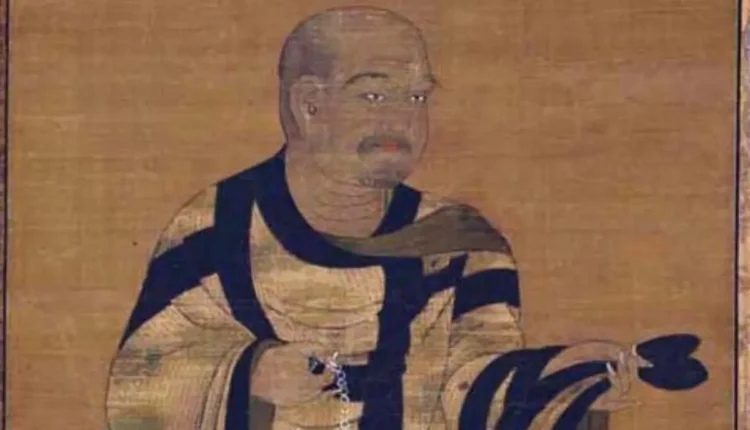In the history of Buddhism, few figures hold a legacy as profound as that of Vajrabodhi, an Indian esoteric Buddhist monk whose teachings reached across countries and cultures, shaping the spiritual landscape of Asia.
Born into a Brahmin family in India, Vajrabodhi emerged as a key figure in the spread of Vajrayana Buddhism from India to China and the Srivijaya Empire. This journey, marked by his dedication to learning, teaching, and translating sacred texts, left an enduring impact on the evolution of Buddhist practices, especially in Shingon Buddhism, one of Japan’s major Buddhist sects.
Early Life and Education of Vajrabodhi
Vajrabodhi’s life began in southern India, with accounts of his birth dating back to 671 CE. Most sources indicate he was born to a Brahmin family in Kanchipuram, where his father served as a royal priest and architect. Other sources, however, suggest Vajrabodhi may have been born in central India, possibly as the son of a king named Īśānavarman. This dual heritage illustrates the reverence he commanded across regions.
Despite the varied accounts of his lineage, the trajectory of Vajrabodhi’s life toward spirituality is undisputed. According to many records, he converted to Buddhism at age sixteen, though some believe he entered the renowned Buddhist university of Nalanda as early as ten.
Displaying intellectual prowess from a young age, Vajrabodhi mastered texts from various traditions, including Jainism. His exposure to these diverse teachings broadened his perspective, equipping him with a comprehensive understanding that would later enhance his own teachings in the esoteric realm.
At Nalanda, Vajrabodhi’s intellectual and spiritual journey flourished under the guidance of esteemed teachers. He studied under Dharmakīrti, a prominent logician, gaining a solid foundation in Buddhist philosophy and logic.
Later, he encountered Santijnana, who introduced him to Vajrayana Buddhism—a transformative moment that would define the rest of his life. Vajrabodhi embraced the rigorous practices of Vajrayana, including esoteric teachings and yoga initiation, setting the stage for his unique contributions to Buddhism in East Asia.
Travels and Spiritual Growth
Vajrabodhi’s quest for deeper knowledge led him beyond India. With a determination to broaden his understanding of esoteric Buddhism, he traveled to Sri Lanka and the Srivijaya Empire (present-day Sumatra, Indonesia).
These regions had long been influential centers of Buddhist thought and practice, and Vajrabodhi found a unique form of Vajrayana teachings distinct from those taught at Nalanda. This Tamraparniyan route, which several scholars traversed before him, exposed Vajrabodhi to the diverse manifestations of Buddhist practice, mirroring the reach of the legendary sage Agastya.
In Srivijaya, Vajrabodhi encountered teachings that would deepen his understanding of ritual, symbolism, and the transformative nature of Vajrayana Buddhism. These influences enriched his spiritual knowledge, preparing him for the next phase of his journey: the introduction of Vajrayana Buddhism to China.
Arrival in China and Founding of the Zhenyan School
Vajrabodhi embarked on a voyage to China in 720 CE, accompanied by thirty-five Persian merchant vessels that provided a protective escort. This monumental journey, bringing him to the Jianfu Temple in Chang’an (modern-day Xi’an), marked the beginning of a new chapter for Chinese Buddhism. By 723, Vajrabodhi had established himself as a respected teacher and translator, accompanied by his disciple, Amoghavajra, who would later become one of the most influential figures in Chinese Buddhism.
At the heart of his teachings in China was the Sarvatathāgatatattvasagraha, a critical text in the Yoga Tantra tradition. His partial translation of this text between 723 and 724, along with the Mahāvairocana Sutra translated by his contemporary Subhakarasimha, became foundational for the development of Zhenyan (True Word) Buddhism in China. This movement would later serve as the basis for Shingon Buddhism in Japan and influence the esoteric branch of the Tendai school.
His commitment to ritual, translation, and teaching endeared him to both the Buddhist community and the Chinese imperial court. He enjoyed the patronage of influential figures, including imperial princesses, and his teachings attracted a diverse following. Among his students was the Korean monk Hyecho, who later embarked on a pilgrimage through India and Persia, further spreading Vajrabodhi’s influence.
Legacy in Esoteric Buddhism
Vajrabodhi’s contributions to Buddhism extended far beyond his teachings in China. His practices included detailed instructions on yoga, mudras, and mantras, as well as the requirements for disciples to enter the sacred mandalas. His guidelines on making offerings, setting up altars, and conducting abhiṣeka (initiation ceremonies) formed a comprehensive blueprint for Vajrayana practice, blending ritual with profound spiritual intent.
Among Vajrabodhi’s notable teachings was the origin story of the Tattvasaṃgraha Tantra. He taught that this sacred text was a revelation from the cosmic Buddha Vairocana to Vajrapani, the bodhisattva.
This transmission reportedly passed through a series of great masters, from an enlightened being at an “iron stupa”—thought by some to be the famous Nagarjuna—to Nāgabodhi, and ultimately to Vajrabodhi himself. This lineage underscored the sanctity of Vajrabodhi’s teachings and the revered position he held as a transmitter of esoteric knowledge.
Beyond Amoghavajra and Yi Xing, Vajrabodhi’s influence extended to other disciples, including Yifu and Huichao, a monk from Silla (modern-day Korea). His teachings are also said to have influenced Chinese exorcism practices, a connection noted by scholars such as Frederick M. Smith and Michael Strickmann. Through these methods, Vajrabodhi introduced elements of ritual power that would shape Chinese spiritual practices for centuries, influencing traditions across the Tang, Five Dynasties, and Song periods.
Lasting Impact and Death
Vajrabodhi’s life of spiritual devotion culminated in 741 CE, the year of his passing. His final resting place south of the Longmen Grottoes symbolizes his legacy in Chinese Buddhism. Following his death, the Tang court awarded him the title of “Guoshi,” or “Teacher of the Realm”—a testament to the respect and reverence he commanded as a spiritual leader. This title underscored Vajrabodhi’s dual role as both a Buddhist teacher and a cultural bridge between India, China, and Southeast Asia.
Also Read:Dwarkanath Kotnis: The Indian Doctor Who Became a Chinese Icon

